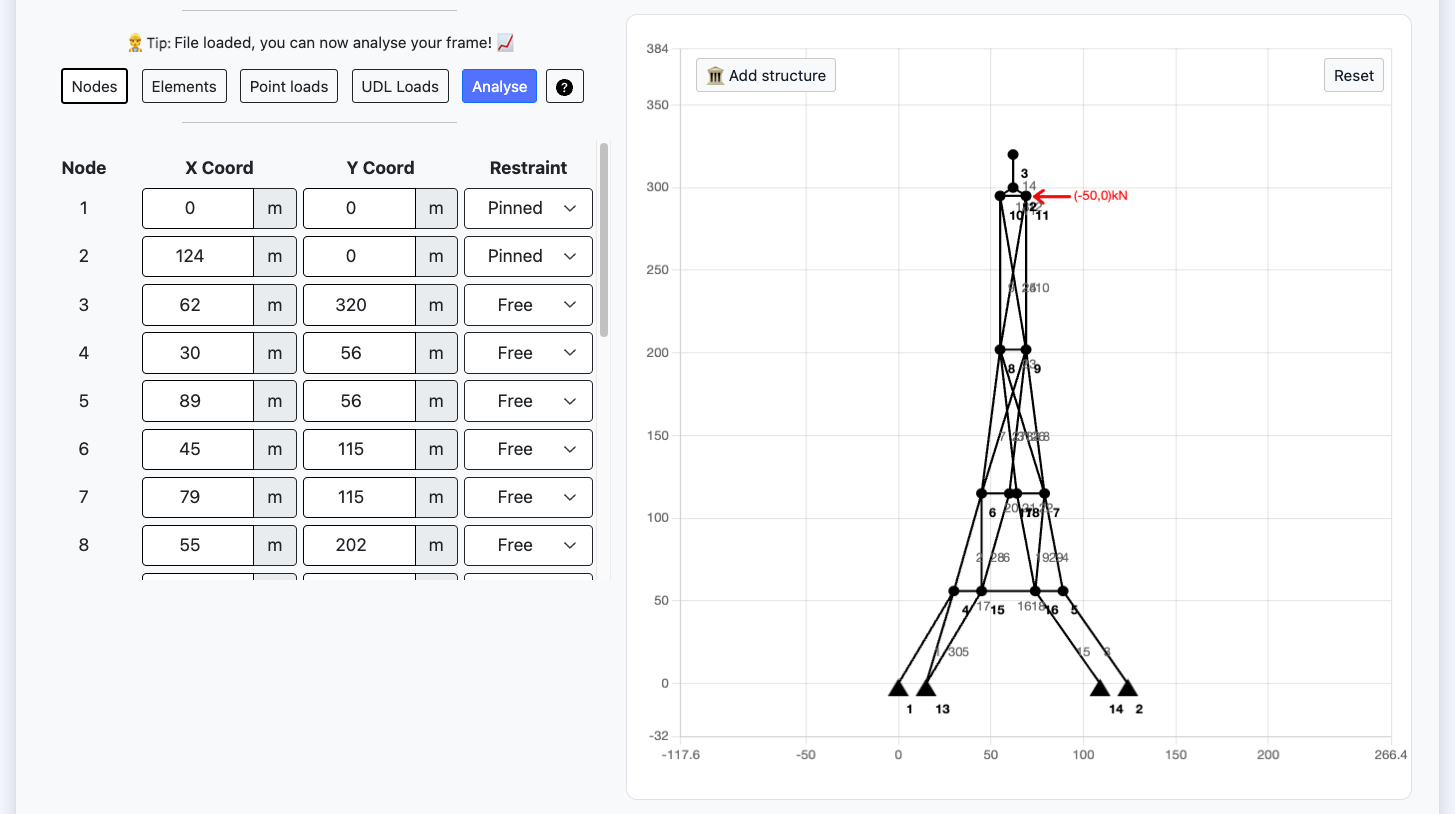Free Reinforced Concrete Caculator
Analyse an RC beam or column design in accordance with Eurocode 2 with this rebar calculator.
Concrete section profile
Concrete Strength fck
MPa
Enter strength more than 0 & less than 60MPa.
Section width
mm
Enter width more than 0 & less than 3000mm.
Section depth
mm
Enter depth more than 0 & less than 3000mm.
Applied loading
Bending Med,y
kNm
Enter moment greater than 0.
Axial Ned
kN
Only axial compression is considered.
Bottom reinforcement
No. bars
Bar diameter
mm
Cover (to bottom)
mm
Enter cover greater than 0 & less than depth/2
Advanced settings:
Shear Ved
kN
Enter shear greater than 0.
Specify the top reinforcement
No. bars
Bar diameter
mm
Cover (to top)
mm
Enter cover greater than 0 & less than depth/2
4. Reinforcement properties:
Steel strength fyk
MPa
Enter strength greater than 0 & less than 700MPa
Cover to edges
mm
Enter cover greater than 0 & less than width/2
Reinforcement spacing
Top bar spacing: mm
Bottom bar spacing: mm
Minimum allowable top bar spacing: mm
Minimum allowable bottom bar spacing: mm
Reinforcement area
Reinforcement area top: mm2
Reinforcement area bottom: mm2
Total reinforcement: mm2 (%)
Min reinforcement limit: mm2 (%)
Max reinforcement limit: mm2 (%)
Result
ULS
%
SLS
%
Warnings:
❌ Top bars seem too close.
❌ Bottom bars seem too close.
❌ Cover to the top seems too little, try >30mm.
❌ Cover to the bottom seems too little, try >30mm.
❌ Cover to the sides seems too little, try >30mm.
❌ Check your reinforcement area is within max & min limits.
| d mm |
x mm |
es1 | es2 | σ's1 N/mm2 |
σ's2 N/mm2 |
M1 Nmm |
M2 Nmm |
M3 Nmm |
M kNm |
N kNm |
|---|
Calculation Results
Loading...
Ultimate limit state
| ULS result | |
| M-N utilisation | % |
| Shear analysis |
Serviceability limit state
| SLS result | |
| Neutral Axis Depth | mm |
| Assumed crack limit | 0.3mm |
| Short term crack width | mm |
| Long term crack width | mm |
Calculation theory
What is concrete used for in construction?
- Concrete’s strength, cost and availability has made it the most widely used construction materials of the 21st century. Concrete is made from cement mixed with water. Often stone aggregate and chemical admixtures are added to the mix to improve the material structural performance and workability. The most common mix of cement, aggregates and water used is in the ratio 1:2:4.
Why is reinforcement needed in concrete?
- Concrete is weak in tension and shear. Steel reinforcement forms a bond with concrete and provides concrete with tensile strength, prevent dangerous brittle failure of the material. Brittle failure is dangerous in unreinforced concrete as occurs suddenly and provides no warning that the material is about to fail.
How to find the neutral axis of reinforced concrete?
- When a beam flexes one face of the beam experiences tensile stress and the other experiences compressive stress. A neutral axis forms, along which line the stress is zero. The neutral axis position depends on the position and specification of any steel reinforcement and the nature of the applied load.
How to calculate concrete bending and axial resistance?
- Each neutral axis position within the concrete section will have a resulting axial and bending resistance. Plotting the axial resistance against the bending resistance for each neutral axis position creates an envelope which represents the capacity of the concrete section.
How to calculate concrete shear link area and resistance?
- Shear links are used to resist shear force applied to concrete. The concrete strut capacity equation is used to determine the area of shear links required to provide the necessary shear link resistance.
How to calculate concrete minimum reinforcement area?
- A minimum reinforcement area of 0.24% of the concrete section area should be provided as a typical value.
- In order to provide crack control and satisfy SLS requirements a minimum area of reinforcement must be provided to concrete. The amount can be estimated from an equilibrium equation between the tensile force in concrete before cracking and the tensile force in reinforcement at yielding.
- Minimum reinforced concrete steel area can be calculated with the equation
- As,mín·σs = kc · k · fct,eff · Act
- Where As,min is equivalent to the minimum area required within the tensile zone.
- Act is the area of concrete within the tensile zone.
- σs is the stress in the steel after crack formation, this can be taken as the yield strength of the steel
- fct,eff is the tensile strength of the concrete
- k is the coefficient which allows for the effect of non-uniform self-equilibrating stresses, which lead to a reduction of restraint forces
- = 1,0 for webs with h ≤ 300 mm or flanges with widths less than 300 mm
- = 0,65 for webs with h ≥ 800 mm or flanges with widths greater than 800 mm
- kc is a coefficient which takes account of the stress distribution within the section immediately prior to cracking and of the change of the lever arm:
- For pure tension kc can be taken as = 1,0, this can also be used for all cases as a conservative value.
How to calculate concrete maximum reinforcement area?
- A maximum of between 1% and 2% of the concrete area should be provided as reinforcement
How to find concrete rebar spacing?
- The minimum spacing between bars should be greater than the bar size, the maximum aggregate size + 5mm, or 20mm according to Eurocode 2 (EC2)
- The minimum horizontal spacing between bars should be greater than the bar size or the maximum aggregate size + 5mm. The minimum vertical spacing between bars should be greater than the bar size or 2/3 of the maximum aggregate size according to BS8110
How to calculate concrete crack widths?
- The compressive stress in the concrete shall be limited in order to avoid longitudinal cracks, micro-cracks or high levels of creep, where they could result in unacceptable effects on the function of the structure.
- Longitudinal cracks may occur if the stress level under the characteristic combination of loads exceeds a critical value. Such cracking may lead to a reduction of durability. In the absence of other measures, such as an increase in the cover to reinforcement in the compressive zone or confinement by transverse reinforcement, it may be appropriate to limit the compressive stress to a lower value for concrete exposed to harsh exposure conditions.
How to design a reinforced concrete column
- Concrete column capacity charts can be used to calculate the reinforcement area requirements from height, width and the applied axial force and bending.
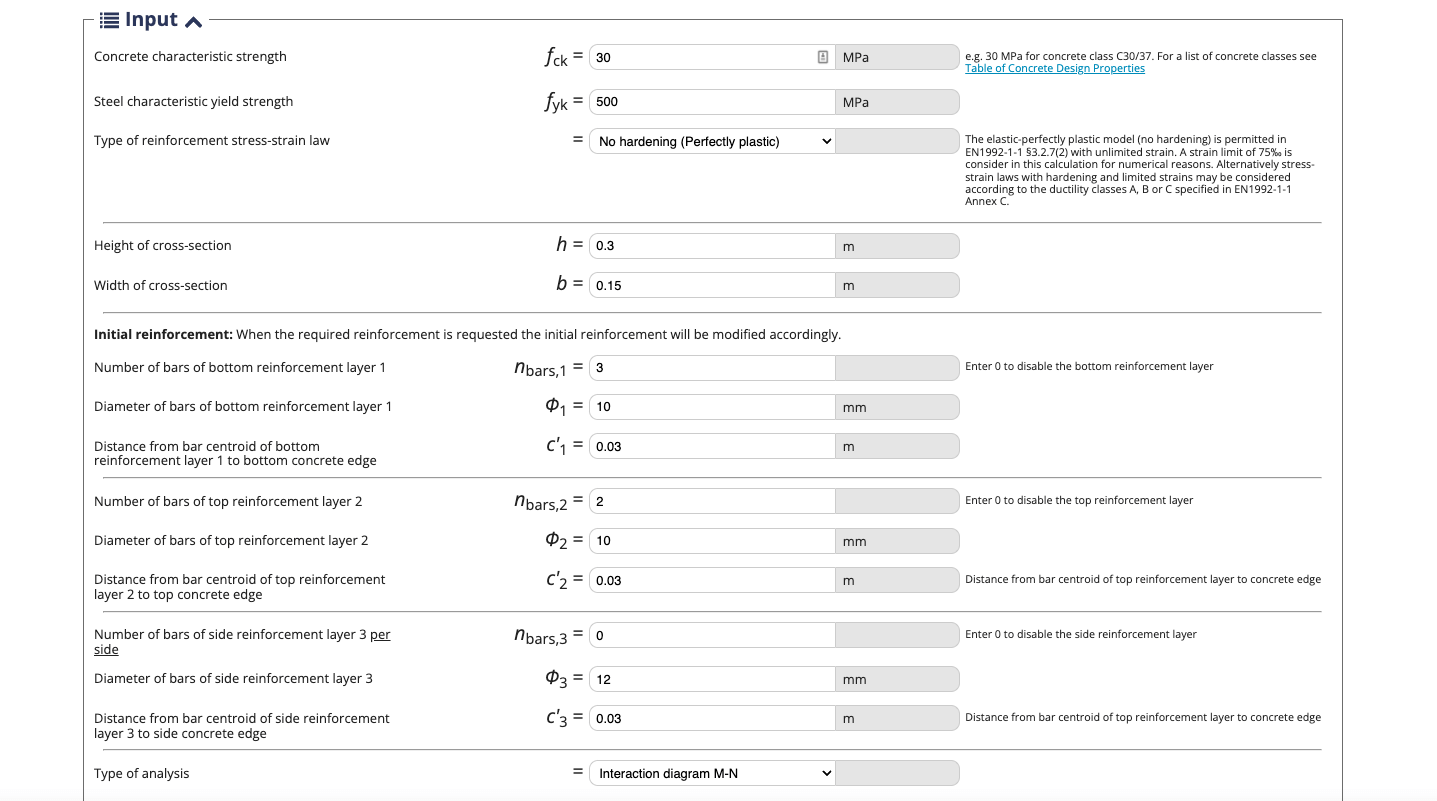
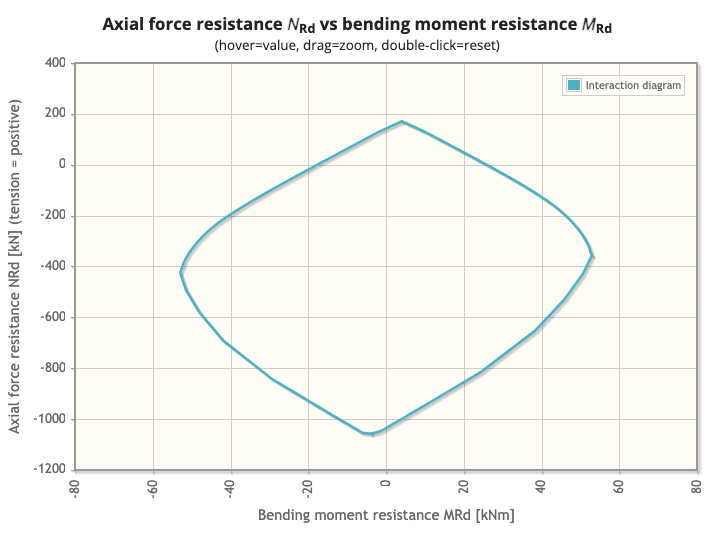
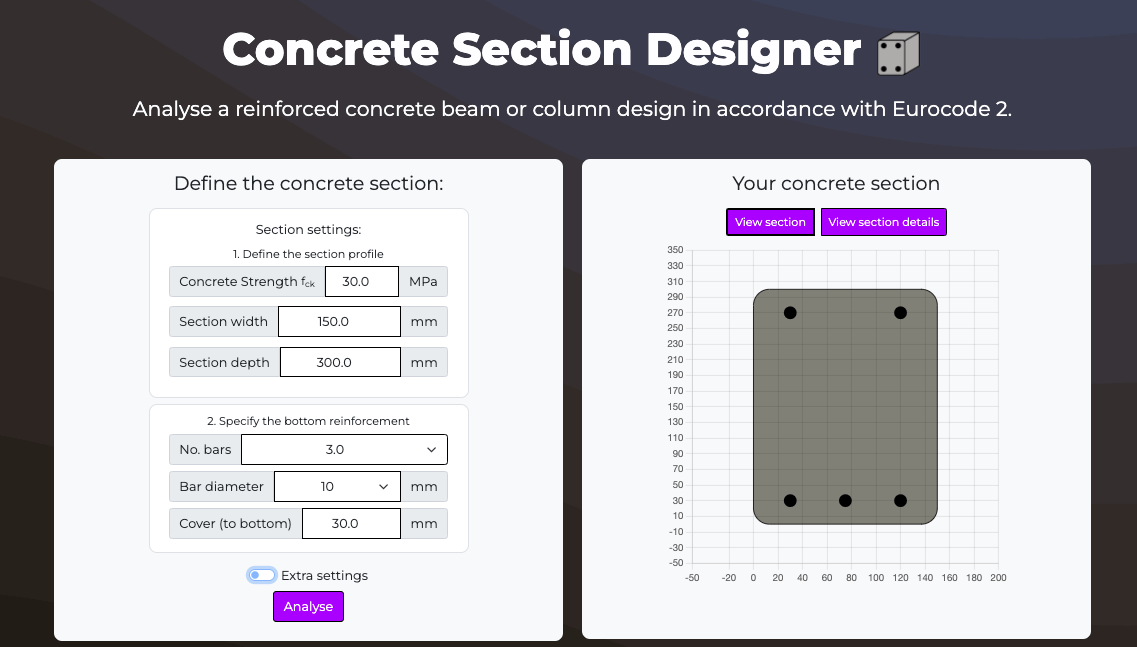
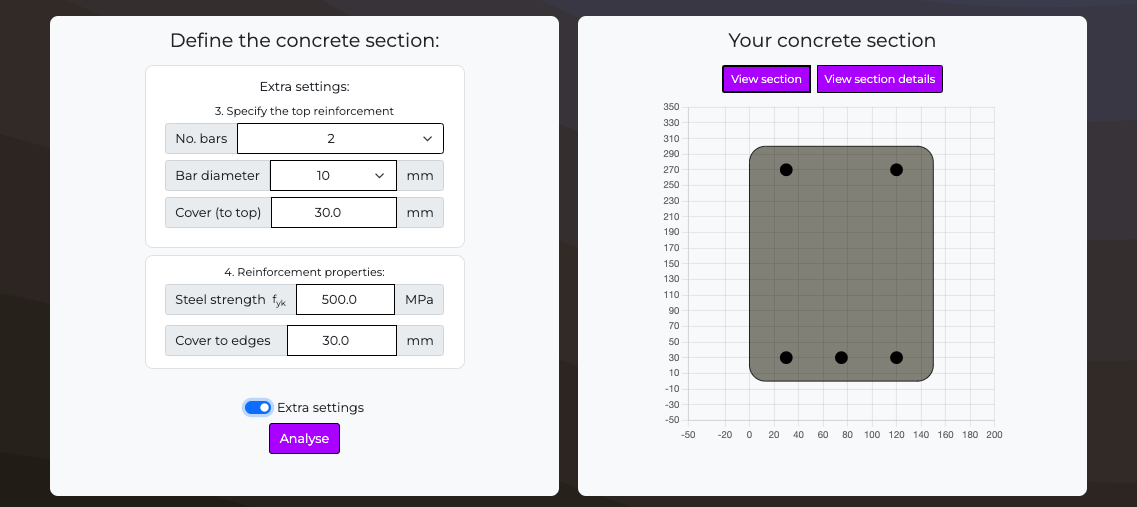
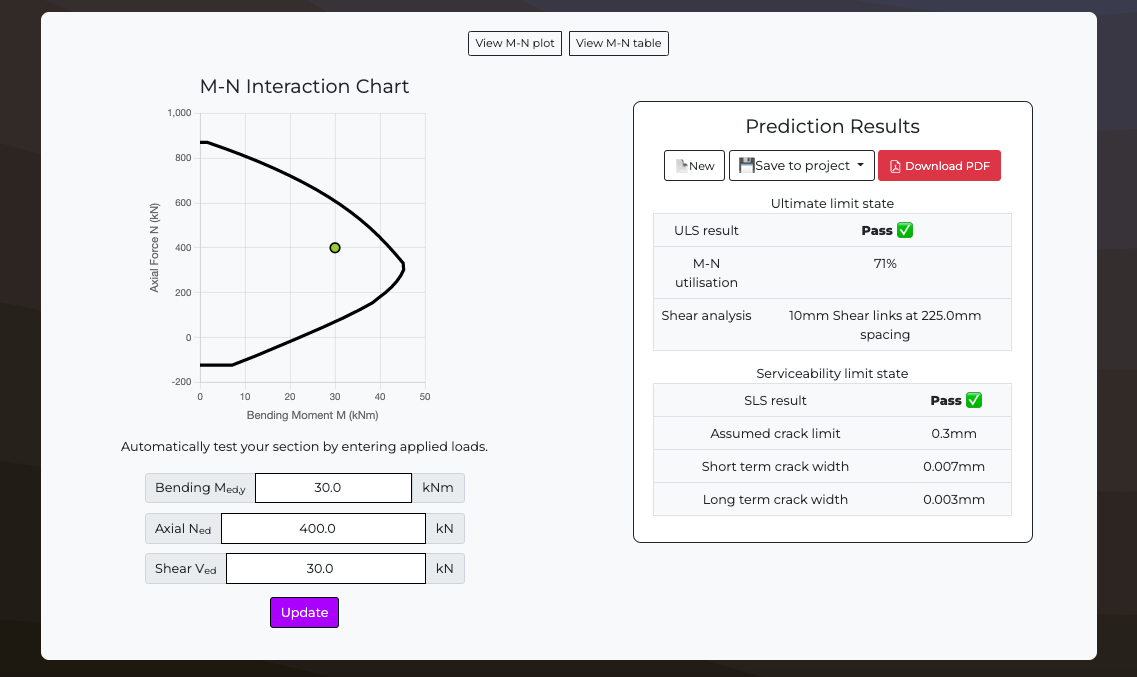
What's this calculator used for?
This free calculator can be used by Civil Engineers to design reinforced concrete. This tool can be used to calculate reinforcement and rebar areas and calculate bar spacings are correct against the European regulations (Eurocode 2). Calculate the neutral axis of a reinforced concrete beams and used it to determine the tension and compression stresses resulting from the bending moment. Design the shear reinforcement and check that concrete short term and long term crack widths comply with servicibility limit state.
Contribute to this code
This code is open source and you can contribute to it's development.
You can find the source code on GitHub here: Concrete-Properties
© 2023 Robbie van Leeuwen
Interested in learning more about automation?

Enroll on our training certifications and learn how to code, build AI applications with no-code tools and automate tasks.

